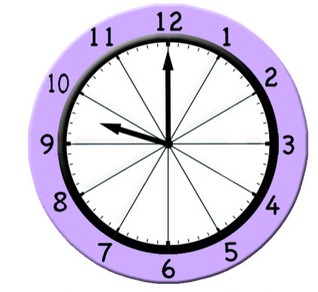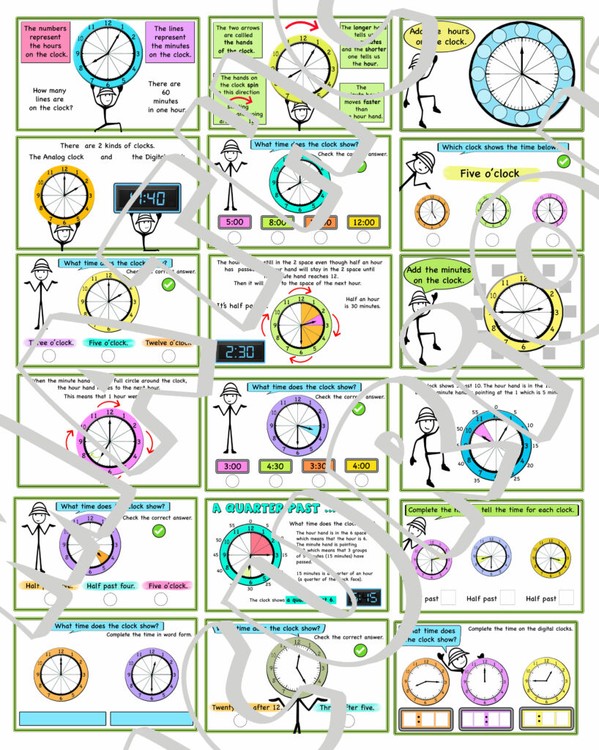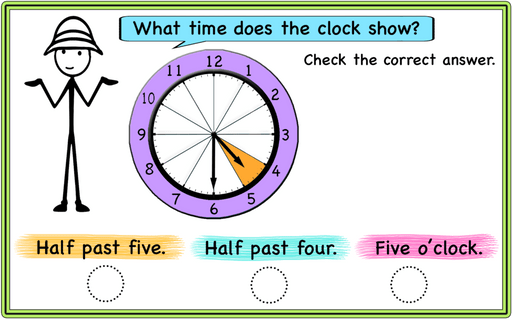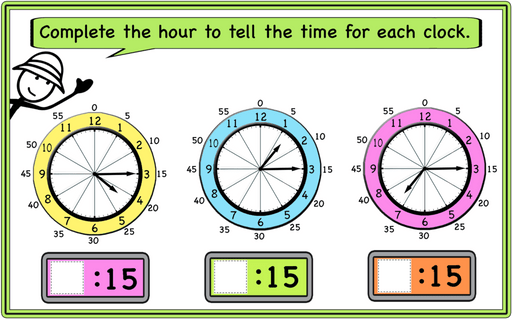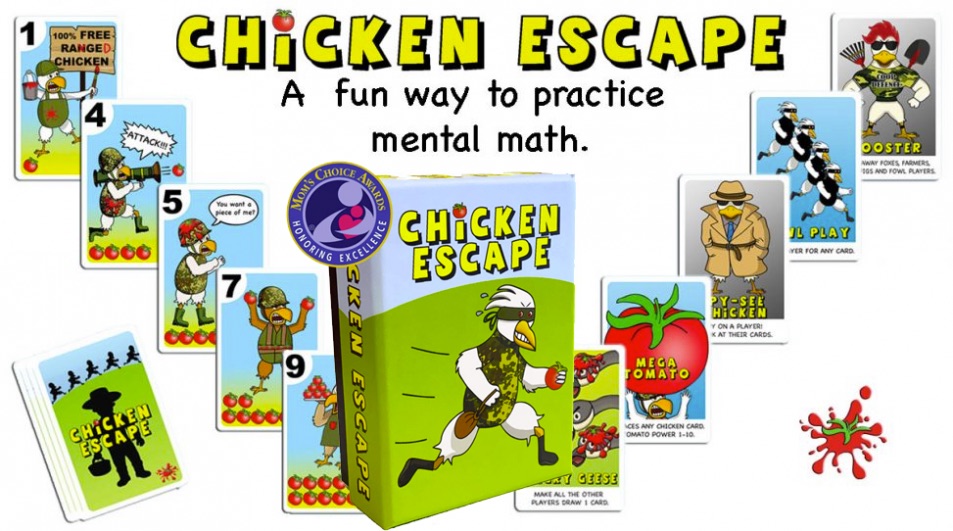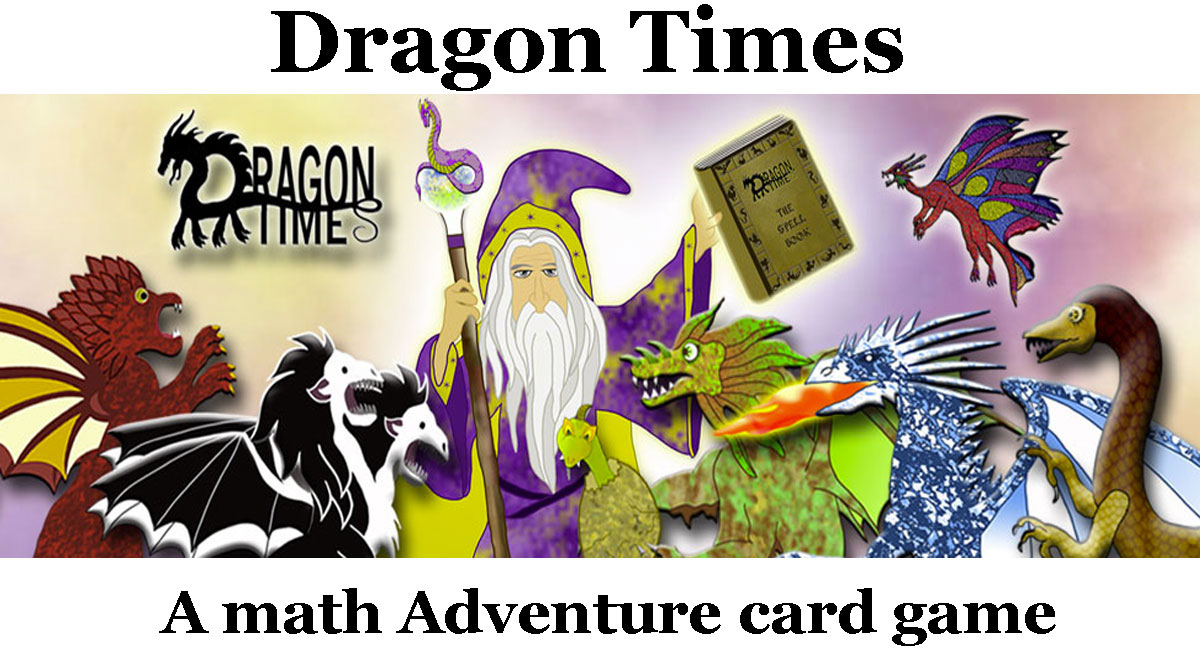Teaching time and specifically teaching how to read the analog clock and elapsed time is often a challenge for parents and teachers. The reason is that the concept of time is still abstract for many students as it doesn’t connect to the other concepts of measurement. The students cannot see, touch, or weigh time. It is hard to visualize and compare time. Time does not use the standard place value. An hour is not 10 or 100 minutes.
We can teach time successfully by using a variety of ordered activities (find some print and digital ones at the end) and by including time activities in our everyday routine to help students connect their knowledge to everyday life and strengthen their understanding. Even after students learn time they will forget if they don’t use it. There are plenty of opportunities every day to use a clock and discuss time. Below are a few tips that can be adjusted based on the grade level.
- When you give students time to do complete a task, measure the time using a clock, a timer, a stopwatch. When you say that we are going out in 10 minutes, keep the timer running and have them look at it often. this will help students understand the duration and the relation of seconds and minutes.
- When students are working in their groups I assign a member the job of timekeeping. Since the jobs rotate everyone gets a turn. The timekeeper has a clock or a timer, checks the time, and informs their teammates.
- Create a schedule of the day, and use clock faces to show the important times of the day. Start, recess, lunch, end. Talk about the changes in the time schedule, the time used for a subject, the length of the breaks, and more.
- Talk about time often. Ask questions like, how much time for recess? Where should the hour hand be to go for lunch? How about the minute hand? Is it before or after 12? Am or pm? “Look at the clock now. How will the clock look when it will be time to go out?”
- Ask students to time short activities with a stopwatch. Get a stopwatch that has a digital display similar to an analog clock. Instead of simply tallying the numbers, the stop watch simulates a second hand moving around the face of a clock.
- Play games with the timer. Like, which team can build the tallest LEGO tower in 1 minute. The tallest stone tower. Give specific time for scavenger hunts.
- Create a Sun clock with your students.
Preparing to teach time.
- When starting with time I use a clock divided into parts for each number. That helps the students understand that the specific hour is not only when the hand points at the specific number but when the hand is in the space of that number. For example, the hour is two at two o clock, at a quarter past 2, at half-past 2, and at a quarter to 3. Only once the minute hand reaches 12 the hour changes. We slowly move to activities with clocks without the divisions.
- Before teaching telling and writing time to the minute make sure that your students can count to 60 by 5. Practice skip counting by 5 and talk about the magic number 60. What is half of 60, What is 1/4 of 60, 3/4 of 60. These activities will help them when counting minutes on the clock.
- Make sure that you have a big analog clock. You can add time vocabulary around/ near it and add cardboard pieces around the clock to mark the minutes.
- Practice placing/writing the numbers hours and minutes on the blank clock in the correct order and direction. Have the students create their own analog clock using paper plates. For younger students, you can provide a template to be placed on the plate.
- Use a real and big analog clock so that you can show the students that both hands move at the same time, and what happens to the hour hand as the minute hand moves, and so on. For this, you can use a digital clock as well. Toy theatre has a great one that allows for modifications like using one hand at a time and works perfectly for elapsed time problems.
- Students tend to forget which hand shows what. A little trick is to notice that the word hour is shorter than the word minutes and so is the hand that shows it.
- You can use a number lines to help solve elapsed time problems. Laminate the number lines so that students can use them many times.
- Use a gear clock for elapsed time so that students can see both hands moving as they move forward or backward. These clocks are good for students to use since they can only move the minute hand and the hour follows accordingly. Gear clocks are a useful manipulative to invest in.
Games/activities
Where is the clock?
This is a fun scavenger hunt game. Place cards with clocks around the classroom. Make sure they are visible. Stick one on the window, on the door, on the ceiling, board, floor …you get the point. Give the students a sheet with the times of the clocks in word form. They need to find the location for each of the time. For example, A quarter to five. It’s the clock on the window. The students work in teams and you can add the competitive element if you want.
Guess the time
A student sets the time on the big analog clock without showing it to the rest of the class. The other students ask yes/no questions and try to guess the time. They can ask questions like, is it o’clock? Is it in the morning? Is it after lunch? Is it school time? Decide on the number of questions the students are allowed to ask in total. We play this in groups and each group is allowed to ask 3 questions, one group at a time. they need to think well about their question.
Find some free print to play games here.
Print and digital activity cards.
We have created a collection of activity cards for teaching time that includes
- Explanations for each concept, o’clock, half past, quarter past and to, minutes, seconds,
- Understanding the clock- placing the numbers for hours and minutes.
- Reading and writing time to the hour.
- Reading and writing time to the half-hour.
- Reading and writing time to the quarter-hour.
- Reading and writing time to the nearest 5,10,25,20 minutes.
- seconds
- discussions
- puzzles
Below is a small sample
and a quick video
Most of the activities include clocks divided in hour parts to help the students understand better. Example below.
There are activities with clocks without parts as well.
The activities are grouped to practice each concept individually and all the concepts together as well.
Below you will find a free and a premium version of the resource.
The premium resource includes 150 print and 150 digital activities. The digital activities are in google slides form that can be easily downloaded as a power point presentation.
For elapsed time activities check out our second collection of print and digital activities that includes:
- Explanations
- AM/PM activities
- 24-hour clock activities
- Starting with elapsed time-adding time, time before and after
- Finding times on the number line.
- Measuring the elapsed time between clocks.
- Word problems – measuring elapsed time in parts, finding the end time.
- Challenge problems
